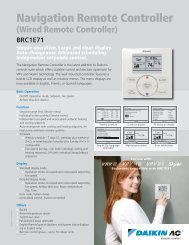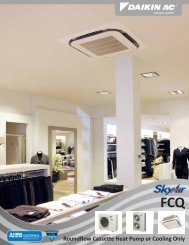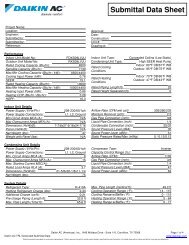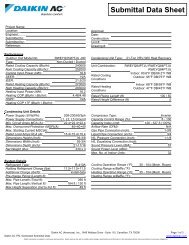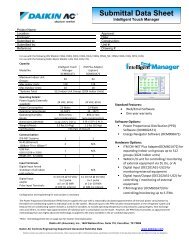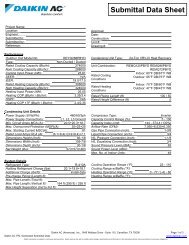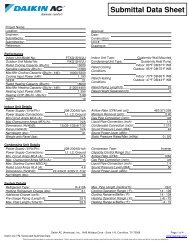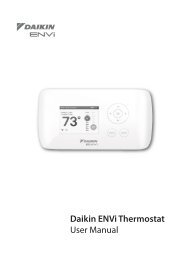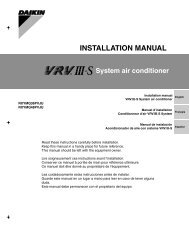INSTALLATION MANUAL - Daikin AC
INSTALLATION MANUAL - Daikin AC
INSTALLATION MANUAL - Daikin AC
You also want an ePaper? Increase the reach of your titles
YUMPU automatically turns print PDFs into web optimized ePapers that Google loves.
WARNING<br />
Be aware that the domestic hot water temperature will be<br />
automatically increased with the value selected in field<br />
setting [5-04] (if the outdoor temperature drops below field<br />
setting [5-03]) compare to the user set point for domestic<br />
hot water (T U ). Refer to field setting [5-03], [7-00] and the<br />
operation manual to select preferable set point.<br />
If this high domestic hot water temperature can be a<br />
potential risk for human injuries, a mixing valve (field<br />
supply) shall be installed at the hot water outlet connection<br />
of the domestic hot water tank. This mixing valve shall<br />
secure that the hot water temperature at the hot water tap<br />
never rise above a set maximum value. This maximum<br />
allowable hot water temperature shall be selected<br />
according to local laws and regulations.<br />
[6] DT for heat pump domestic water heating mode<br />
Applies only to installations with a domestic hot water tank.<br />
The 'DT (temperature difference) for heat pump domestic water<br />
heating mode' field settings determine the temperatures at which<br />
heating of the domestic hot water by the heat pump will be started<br />
(i.e., the heat pump ON temperature) and stopped (i.e., the heat<br />
pump OFF temperature).<br />
When the domestic hot water temperature drops below the heat<br />
pump ON temperature (T HP ON ), heating of the domestic hot water by<br />
the heat pump will be started. As soon as the domestic hot water<br />
temperature reaches the heat pump OFF temperature (T HP OFF ) or<br />
the user set point temperature (T U ), heating of the domestic hot water<br />
by the heat pump will be stopped (by switching the 3-way valve).<br />
The heat pump OFF temperature, and the heat pump ON<br />
temperature, and its relation with field settings [6-00] and [6-01] are<br />
explained in the illustration below.<br />
■ [6-00] Start: temperature difference determining the heat<br />
pump ON temperature (T HP ON ). See illustration.<br />
■ [6-01] Stop: temperature difference determining the heat<br />
pump OFF temperature (T HP OFF ). See illustration.<br />
T(°C)<br />
70<br />
T U > T HP MAX<br />
T(°F)<br />
158 T U<br />
T U = 158°F (70°C)<br />
[6-01] = 3.6°F (2°C)<br />
[6-00] = 12.6°F (7°C)<br />
[6-01]<br />
T HP ON<br />
50 122<br />
48 118.4<br />
T HP MAX<br />
T HP OFF<br />
41 105.8<br />
[6-00]<br />
T U < T HP MAX<br />
T(°C)<br />
T(°F)<br />
T U = 113°F (45°C)<br />
[6-01] = 3.6°F (2°C)<br />
[6-00] = 12.6°F (7°C)<br />
50 122 T HP MAX<br />
45 113 T U = T HP OFF<br />
38 100.4 T HP ON<br />
[6-00]<br />
T U<br />
T HP MAX<br />
T HP OFF<br />
T HP ON<br />
User set point temperature (as set on the user interface)<br />
Maximum heat pump temperature at sensor in domestic hot<br />
water tank (122°F)(50°C)(depending on T A ) (a)<br />
Heat pump OFF temperature<br />
Heat pump ON temperature<br />
(a)<br />
122°F (50°C) = T HP MAX at T A ≤77°F (25°C).<br />
118.4°F (48°C) = T HP MAX at T A >77°F (25°C).<br />
The maximum domestic hot water temperature that can be<br />
reached with the heat pump is 122°F (50°C). It is advised<br />
to select T HP OFF not higher than 118.4°F (48°C) in order<br />
to improve performance of the heat pump during domestic<br />
water heating mode.<br />
When setting [4-03]=0 or 2 special attention to setting<br />
[6-00] is recommended. A good balance between the<br />
required domestic hot water temperature and heat pump<br />
ON temperature (T HP ON ) is a must.<br />
Installation manual<br />
28<br />
EKHBH/X054BA<br />
Indoor unit for air to water heat pump system<br />
4PW54216-1




